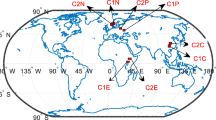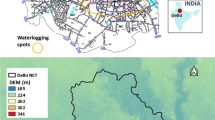Abstract
Extreme flood events are complex and inherently uncertain phenomenons. Consequently forecasts of floods are inherently uncertain in nature due to various sources of uncertainty including model uncertainty, input uncertainty, and parameter uncertainty. This paper investigates two types of natural and model uncertainties in extreme rainfall–runoff events in a semi-arid region. Natural uncertainty is incorporated in the distribution function of the series of annual maximum daily rainfall, and model uncertainty is an epistemic uncertainty source. The kinematic runoff and erosion model was used for rainfall–runoff simulation. The model calibration scheme is carried out under the generalized likelihood uncertainty estimation framework to quantify uncertainty in the rainfall–runoff modeling process. Uncertainties of the rainfall depths—associated with depth duration frequency curves—were estimated with the bootstrap sampling method and described by a normal probability density function. These uncertainties are presented in the rainfall–runoff modeling for investigation of uncertainty effects on extreme hydrological events discharge and can be embedded into guidelines for risk-based design and management of urban water infrastructure.







Similar content being viewed by others
References
Ames D (2006) Estimating 7Q10 confidence limits from data: a bootstrap approach. J Water Resour Plan Manage 132:204–208
Bates BC, Campbell EP (2001) A Markov chain Monte Carlo scheme for parameter estimation and inference in conceptual rainfall–runoff modelling. Water Resour Res 37:937–947
Beven KJ, Binley AM (1992) The future of distributed models: model calibration and uncertainty prediction. Hydrol Process 6:279–298
Beven K, Smith P, Freer J (2007) Comment on ‘‘Hydrological forecasting uncertainty assessment: incoherence of the GLUE methodology’’, by P. Mantovan and E. Todini. J Hydrol 338:315–318
Beven K, Smith P, Freer J (2008) So just why would a modeler choose to be incoherent? J Hydrol 354:15–32
Blasone RS, Madsen H, Rosbjerg D (2008) Uncertainty assessment of integrated distributed hydrological models using GLUE with Markov chain Monte Carlo sampling. J Hydrol 353(18–32):18–32
Callies U, Scharfe M, Ratto M (2008) Calibration and uncertainty analysis of a simple model of silica-limited diatom growth in the Elbe River. Ecol Model 213:229–244
Chen W, Chau KW (2006) Intelligent manipulation and calibration of parameters for hydrological models. Int J Environ Pollut 28(3–4):432–447
Cullen AC, Frey HC (1999) Probabilistic techniques in exposure assessment, a handbook for dealing with variability and uncertainty in models and inputs. Plenum Press, New York
Davison A, Hinkley D (1997) Bootstrap methods and their application. Cambridge University Press, Cambridge
Dunn P (2001) Bootstrap confidence intervals for predicted rainfall quantiles. Int J Climatol 21:89–94
Efron B, Tibshirani R (1993) An introduction to the bootstrap. Chapman & Hal, New York
Fowler H, Ekström M (2009) Multi-model ensemble estimates of climate change impacts on UK seasonal precipitation extremes. Int J Climatol 29:385–416
Gallagher M, Doherty J (2007) Parameter estimation and uncertainty analysis for a watershed model. Environ Model Softw 22:1000–1020
Goldstein J, Mirza M, Etkin D, Milton J (2003) Hydrologic assessment: application of extreme value theory for climate extreme scenarios construction. In: 14th Symposium on global change and climate variations, California
Goodarzi E, Mirzaei M, Ziaei M (2012) Evaluation of dam overtopping risk based on univariate and bivariate flood frequency analyses. Can J Civ Eng 39(4):374–387. doi: 10.1139/l2012-012
Haimes YY (1998) Risk modeling, assessment, and management, Wiley Series in Systems Engineering. Wiley, New York
Hall M, Boogaard V, Fernando R, Mynett A (2004) The construction of confidence intervals for frequency analysis using resampling techniques. Hydrol Earth Syst Sci 8:235–246
IPCC (2002) Workshop on changes in extreme weather and climate events. Workshop report, Beijing
Kyselý J, Beranová R (2009) Climate change effects on extreme precipitation in central Europe: uncertainties of scenarios based on regional climate models. Theor Appl Climatol 95:361–374
Lindblom E, Ahlman S, Mikkelsen PS (2011) Uncertainty-based calibration and prediction with a stormwater surface accumulation-washoff model based on coverage of sampled Zn, Cu, Pb and Cd field data. Water Res 45(13):3823–3835
Makowski D, Wallach D, Tremblay M (2002) Using a Bayesian approach to parameter estimation, comparison of the GLUE and MCMC methods. Agronomie 22:191–203
Mantovan P, Todini E (2006) Hydrological forecasting uncertainty assessment: incoherence of the GLUE methodology. J Hydrol 330:368–381
Mantovan P, Todini E, Martina MV (2007) Reply to comment by Keith Beven, Paul Smith, and Jim Freer on ‘‘Hydrological forecasting uncertainty assessment: incoherence of the GLUE methodology”. J Hydrol 338:319–324
Mirzaei M, Galavi H, Faghih M, Huang YF, Lee TS, El-Shafie A (2013a) Model calibration and uncertainty analysis of runoff in the Zayanderood River basin using generalized likelihood uncertainty estimation (GLUE) method. J Water Supply: Res Technol—AQUA 62(5):309–320
Mirzaei M, Huang Y, Lee Teang Shui, El-Shafie A, Ghazali A (2013b) Quantifying uncertainties associated with depth duration frequency curves. Nat Hazards. doi:10.1007/s11069-013-0819-3
Mirzaei M, Huang Y, El-Shafie A, Akib S (2015) Application of the generalized likelihood uncertainty estimation (GLUE) approach for assessing uncertainty in hydrological models: a review. Stoch Environ Res Risk Assess. doi:10.1007/s00477-014-1000-6
Salarpour M, Yusop Z, Yusof F, Shahid S, Jajarmizadeh M (2013) Flood frequency analysis based on t-copula for Johor River, Malaysia. J Appl Sci 13(7):1021–1028
Sohrabi TM, Shirmohammadi A, Chu TW, Montas H, Nejadhashemi AP (2003) Uncertainty analysis of hydrologic and water quality predictions for a small watershed using SWAT2000. Environ Forensics 4:229–238
Twardosz R (2009) Probabilistic model of maximum precipitation depths for Kraków (southern Poland, 1886–2002). Theor Appl Climatol 98:37–45. doi:10.1007/s00704-008-0087-4
van Asselt MBA, Rotmans J (2002) Uncertainty in integratedassessment modelling. Clim Change 54(1):75–105
Vázquez R, Feyen J (2010) rainfall–runoff modelling of a rocky catchment with limited data availability: defining prediction limits. J Hydrol 387(1–2):128–140
Xu Y-P, Booij M, Tong Y-B (2010) Uncertainty analysis in statisticalmodeling of extreme hydrological events. Stoch Environ Res Risk Assess 24:567–578
Author information
Authors and Affiliations
Corresponding author
Rights and permissions
About this article
Cite this article
Mirzaei, M., Huang, Y.F., El-Shafie, A. et al. Uncertainty analysis for extreme flood events in a semi-arid region. Nat Hazards 78, 1947–1960 (2015). https://doi.org/10.1007/s11069-015-1812-9
Received:
Accepted:
Published:
Issue Date:
DOI: https://doi.org/10.1007/s11069-015-1812-9




